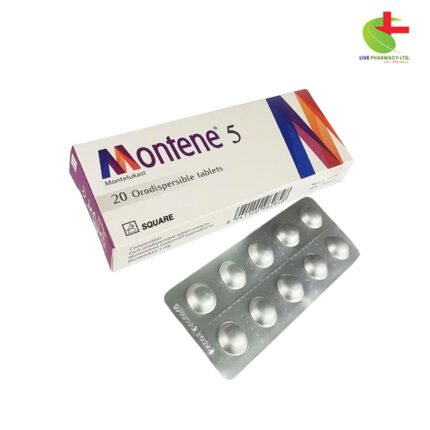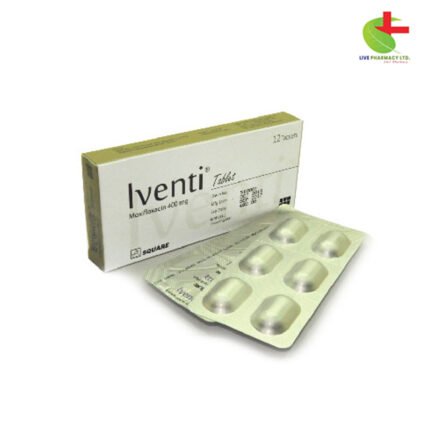Montene 10
160.00৳ Strip
- Montene: Your go-to solution for asthma and allergic rhinitis management.
- Contains Montelukast, a trusted ingredient for addressing chronic asthma and exercise-induced bronchoconstriction.
- Effectively relieves symptoms of allergic rhinitis, offering relief from seasonal and perennial triggers.
- Targets leukotriene receptors, addressing airway constriction and inflammation for improved breathing.
- Available in convenient dosages for both adults and pediatric patients.
 Brand
Brand
|
Square Pharmaceuticals PLC |
|---|---|
 Generics
Generics
|
Montelukast Sodium |
Conditions Montene Treats
Montene is recommended for the following conditions:
- Asthma Management: Used for both preventing and managing chronic asthma symptoms.
- Exercise-Induced Bronchoconstriction (EIB): Provides acute prevention during physical activities.
- Allergic Rhinitis Relief: Effective for alleviating symptoms of both seasonal and perennial allergic rhinitis.
Pharmacological Insights
Montelukast, the active ingredient in Montene, acts as a selective oral leukotriene receptor antagonist. It works by inhibiting the cysteinyl leukotriene receptor (CysLT1). These leukotrienes, generated during arachidonic acid metabolism and released from various cells like mast cells and eosinophils, play a crucial role in asthma and allergic rhinitis pathophysiology. By targeting these receptors, Montene helps alleviate symptoms such as airway edema, smooth muscle contraction, and inflammatory responses associated with these conditions.
Dosage and Usage Instructions
For adults and adolescents aged 15 years and older with asthma or allergic rhinitis, the recommended dosage is one 10 mg Montelukast tablet daily. Pediatric patients should adhere to the following dosages:
- Ages 6 to 14 years: One 5 mg tablet daily.
- Ages 2 to 5 years: One 4 mg tablet daily.
- Ages 6 months to 5 years: One 4 mg oral granule daily, which can be administered directly or mixed with cold water or soft food at room temperature.
Pediatric Usage: Montelukast’s safety and efficacy have been established in children aged 6 months to 14 years, with profiles resembling those in adults.
Special Considerations
- Hepatic and Renal Function: No dosage adjustment is required for patients with mild-to-moderate hepatic or renal insufficiency.
- Elderly Use: Elderly patients can follow the same dosage regimen as adults, with no adjustment necessary.
Interactions
Montene has been administered alongside various therapies for asthma without notable increases in adverse reactions. It doesn’t significantly affect the pharmacokinetics of drugs like theophylline, prednisone, or oral contraceptives. While specific interaction studies weren’t conducted, Montene showed compatibility with commonly prescribed medications. However, phenobarbital reduced Montene’s exposure by approximately 40%, so cautious monitoring is advised when co-administered with potent enzyme inducers.
Contraindications and Side Effects
Montelukast is contraindicated in individuals hypersensitive to any of its components. Common side effects may include gastrointestinal discomfort, headache, and upper respiratory tract infections.
Pregnancy and Lactation
Although Montelukast crosses the placenta in animal studies, its safety in pregnant women hasn’t been fully established. It should be used during pregnancy only if clearly needed, with caution exercised during lactation due to potential excretion in breast milk.
Precautions and Warnings
Montene isn’t meant for reversing bronchospasm in acute asthma attacks. Patients should maintain access to rescue medication and continue Montene therapy during exacerbations under medical supervision. It’s not intended for monotherapy in exercise-induced bronchospasm. Patients with known aspirin sensitivity should continue avoidance, as Montene doesn’t truncate bronchoconstrictor response to aspirin.
Overdose Effects and Storage
Most overdoses reported no adverse events beyond typical side effects. Usual supportive measures should be employed if overdose occurs. Montene should be stored in a cool, dry place below 30°C, shielded from light and moisture, and out of reach of children.
Chemical Structure and FAQs
Montene contains Montelukast Sodium, with a chemical structure represented by C35H36ClNO3S. Frequently asked questions cover its uses, onset of action, duration, administration, missed doses, pregnancy precautions, and general usage instructions.













Reviews
There are no reviews yet.